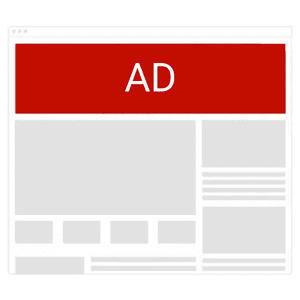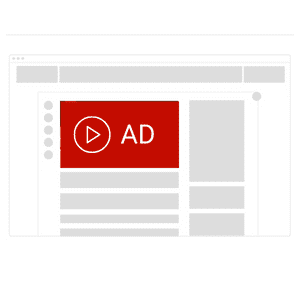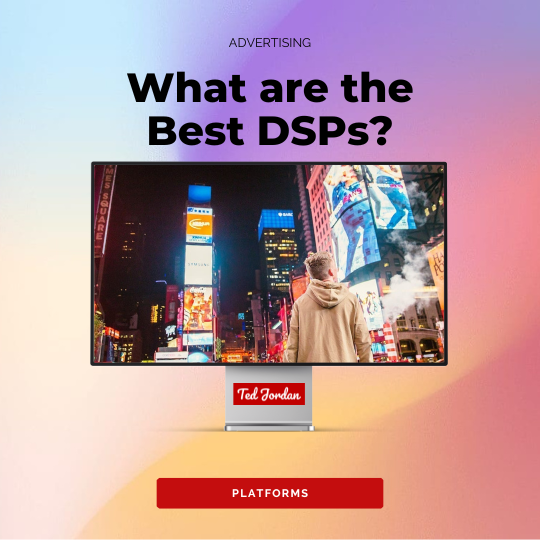There is a vast array of Programmatic ad formats nowadays: Display, Video, DOOH, Native, etc. Some of these ad formats are only available on certain devices like 320×50 banners on mobile.
Today, learn the basics of Programmatic ad formats: simple words, short descriptions and examples. This article is perfect for beginners!
Main Programmatic Ad Formats
In digital marketing, you can advertise in different ways: Programmatic ads, paid search advertising (SEA with Google Ads), social media marketing (SMM such as Facebook Ads). There is no right nor wrong way to do it, you just need to find the right type of advertising for your business.
Today, we’ll talk about the most popular Programmatic ad formats: Display, Native, CTV, Audio… All these ads can be purchased on Demand-Side Platforms.
Programmatic ads are more and more used by small and large businesses around the world. The large number of available Programmatic ad formats plays an important role in advertising campaigns success. It’s crucial to understand how Programmatic formats work, even more if you run a multi-market campaign.
Display ads
Display ads, or Programmatic banner ads, are the ads you mainly see on websites and as publisher ad spaces. The most common sizes are 970×250 (also called Billboard) for desktop; 300×250 and 320×50 for mobile. The ad spaces are usually appearing at the top, at the bottom, or on the side of the screen. These ads can be static or animated, and responsive (adjustable depending on the device).
This Programmatic ad format is not as intrusive as other formats; users tend to click on them intentionally.
Display ads are usually sold on a cost-per-impression model (CPM) or at a fixed cost (Cost Per Day – CPD for example).

Native ads
Native ads are displayed on desktop, mobile and tablet and look similar to the page content they are displayed on. This Programmatic ad format is one of the most prevalent formats in online advertising because of its “natural” look. Native ads are often present on news pages.
Native ads are generally created with an image, a headline, a description, a logo, a CTA (Call To Action) and a click URL. They can be displayed as carrousels, mobile interscrollers, videos, etc.
This Programmatic ad format is generally purchased on a CPM, CPC, or fixed CPC model.
Audio ads
The most popular Programmatic audio ads are delivered through music streaming platforms, podcasts or online radios. An audio ad is an ad that plays before or during audio content.
This advertising format is perfect to reach specific already engaged listeners based on their location or/and listening habits. It’s often used in combination with other Programmatic ad formats, to remind listeners about products they might have seen in their daily routine.
Programmatic audio ads are usually sold on a CPM (Cost Per 1,000 listeners) model.
Video ads
Video ads run usually before or between (sometimes after) premium content and can be integrated with display format across multiple screens. One of the most common video ad formats is Pre-Roll (video clip that plays before a featured content) on desktop or on mobile.
There are 2 main types of video ads: instream videos (think about video ads on YouTube for example) and out stream videos (videos displayed between an online article for example).
This popular ad format can be sold on a CPV (Cost Per View) model or CPM. It depends on the specific format, type of the video, publisher, etc.

CTV
CTV (Connected TV) ads are part of video ads but are becoming more popular within the years. Indeed, an increasing number of households own connected TV these days so marketing opportunities are growing exponentially.
CTV advertising delivers ads to people watching specific content, playing specific games or using a certain gaming console, for example. These Programmatic ads can be served as video ads or display ads.
Large screen sizes and long form contents allow advertisers to add more elements in their CTV ads. For example, the use of QR codes is increasing: users usually watch TV with their mobile phone next to them. If they see a QR code, they will probably scan it with their phone.
CPM is usually used as a pricing model for CTV ads.
DOOH
DOOH, or Digital Out-Of-Home, is a popular Programmatic ad format allowing advertisers to serve their ads on digital screens (billboards) in public places like airports, pharmacies, train stations, etc.
They can be displayed in specific shops, during a specific time of the day/night or only in rainy days, for example. Targeting opportunities are endless; even retargeting is possible!
DOOH pricing model is usually CPM, with the average number of people seeing the ad per impression taken into account.
Rich media ads
Rich media ads are different from other Programmatic ad formats because users can interact with them. For example, ads could be served as a game, a form to complete, etc.
The goal of rich media ads is to create interaction: audiences interact with these ad formats by playing a game, swiping, scratching or touching ads. There is a large variety of interactions possible and pricing models are adjusted accordingly.
Selecting the right Programmatic Ad Format
There are no right nor wrong ad formats in Programmatic but choosing the wrong ad formats for a marketing campaign can be disastrous. That’s why it’s important to know how ad formats work, what their cost is and how to reach your target audience.
What are your objectives?
Defining your campaign objectives is key: is it reach, brand awareness, consideration, conversions? Depending on your objectives, some ad formats may be better than others.
For example, native ads are great to increase website visits and conversions. So are other ad formats… but they might be more expensive.
Keep your budget in mind
Programmatic ads pricing is variable: ad format, location, device, ad complexity, etc. all play an important role. It’s important you keep your budget in mind to pick one or more Programmatic ad formats you can afford.
For example, DOOH ads in big cities, like New York or Houston, will be much more expensive than display or native ads. Or you might have to spend a minimum threshold to be able to deliver on some ad formats.
A Programmatic expert can help you plan a budget per ad format and pick ad formats tailored to your needs.

Best Ad Format for your audience
Your target audience is as important as your budget, or your marketing campaigns objectives. Different ad formats might better suit different target audiences: advertise where your audience is. Also, discover what digital ad formats your audience loves and hates to optimise your campaigns.
If you target males and females, 20+, who love beauty products, you may want to buy DOOH ads in malls where there are beauty shops and avoid delivering native ads on blogs talking about “no make-up looks”.
Knowing the intricacies of Programmatic and how to use ad formats at their best is important to succeed in digital marketing.
Understand Programmatic Ad Formats
Understanding how Programmatic ad formats work and when to use them will make a difference between average marketing campaigns and profitable ones.
You can learn about ad formats by reading articles like this one or by asking a Programmatic Expert, like Ted Jordan, to help you.
There are also some great online Programmatic Advertising Courses available to expand your knowledge in this field. If you’re curious to learn more about Programmatic and ad formats, check out our free overview course and learn how to set up a campaign on a popular DSP.
FREE – No credit card needed



